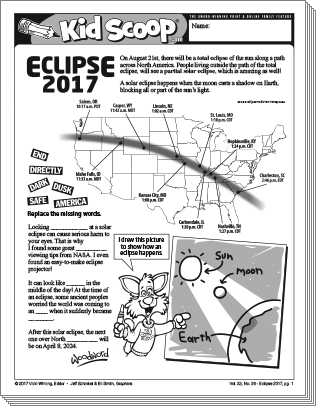 It’s the middle of a beautiful sunny day—and slowly the sun changes to a dark disk as the moon passes in front until the sun’s entire face is covered ringed by a glowing halo. Although ancient people were understandably terrified when this happened, we know today that a total solar eclipse is only temporary. Soon the moon will continue its orbit and the sun will return to normal. Somewhere on the earth a solar eclipse—either whole or partial—occurs approximately once every 18 months. Chances are you’ll experience it sometime in your life. When you do, you’ll be prepared with the facts and ideas for safe viewing included in this issue! This is one time you’ll need to leave your sunglasses behind and observe like a scientist following NASA’s instructions.
It’s the middle of a beautiful sunny day—and slowly the sun changes to a dark disk as the moon passes in front until the sun’s entire face is covered ringed by a glowing halo. Although ancient people were understandably terrified when this happened, we know today that a total solar eclipse is only temporary. Soon the moon will continue its orbit and the sun will return to normal. Somewhere on the earth a solar eclipse—either whole or partial—occurs approximately once every 18 months. Chances are you’ll experience it sometime in your life. When you do, you’ll be prepared with the facts and ideas for safe viewing included in this issue! This is one time you’ll need to leave your sunglasses behind and observe like a scientist following NASA’s instructions.
In this issue young skywatchers will:
- Understand the science of a solar eclipse
- Follow directions for safe viewing
- Read expository text closely to complete a “cloze” activity with scientific vocabulary
- Use the newspaper to explore eclipse adjectivesv
- Calculate times to solve an eclipse puzzler
- Practice observation skills with newspaper photographs
- Write creatively about outer space cold …
- Discover a scientific experiment about the effect of eclipse on animal behavior
6 page PDF
